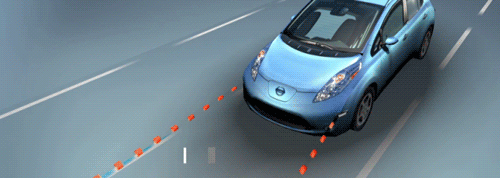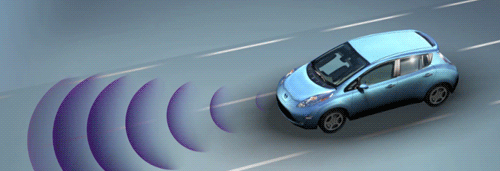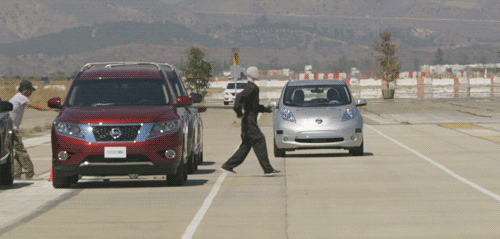Need to Know: 6 questions you should ask about driverless cars
On this week’s “TechKnow,” contributor Kosta Grammatis explores the future of automotive technology: the driverless car. He takes a ride in Nissan’s prototype autonomous LEAF and meets a legally blind man who got back “behind the wheel” to test Google’s self-driving car. Here’s some background on what you should know about this technology and what it means for our future.
1. How close are we?
“Giving automobiles auto-piloting features—up to and including completely hands-free, eyes-closed operation with trusting souls aboard—is the Space Race of global auto makers, and you are the monkey in the capsule. Last month Nissan and Renault chief Carlos Ghosn promised that Nissan would bring affordable autonomous cars to the public by 2020. Mercedes-Benz already markets some of its driver-assist technologies as ‘semiautonomous’: automatic lane keeping (positioning the car between the lines during brief periods of hands-off operation); and Stop & Go Pilot, an optics-and-radar-based cruise control that can see traffic ahead and adjust speed in heavy traffic.”
-The Wall Street Journal: “Driverless Cars for the Road Ahead”
2. How does it work?
Nissan's autonomous LEAF protoype uses laser scanners to sense objects and its surroundings. A front radar panel can see the road up to 200 meters (about 656 feet) ahead and rear radar panels range up to 70 meters (230 feet). The car also includes sonar capabilities to help with parking and cameras on each side of the car.



Autonomous mode, which can be activated by pushing a button on the driver’s side, gives auditory notifications so the driver knows what the car is doing and why. Cameras read the lines on the road to keep the car on course, and can even sense red lights and stops signs, adjusting accordingly.
The cameras and lasers are also used to sense any obstacles that suddenly appear on the road, like a child or dog running into the street. Once an obstacle is detected, the car reads its surroundings to determine whether to swerve or brake to avoid an accident.

The LEAF can also use its sonar capabilities to find an available parking spot and park itself.

3. What are the different levels of vehicle automation?
The U.S. Department of Transportation's National Highway Traffic Safety Administration (NHTSA) defines vehicle automation as having five levels:
No-Automation (Level 0): The driver is in complete and sole control of the primary vehicle controls – brake, steering, throttle, and motive power – at all times.
Function-specific Automation (Level 1): Automation at this level involves one or more specific control functions. Examples include electronic stability control or pre-charged brakes, where the vehicle automatically assists with braking to enable the driver to regain control of the vehicle or stop faster than possible by acting alone.
Combined Function Automation (Level 2): This level involves automation of at least two primary control functions designed to work in unison to relieve the driver of control of those functions. An example of combined functions enabling a Level 2 system is adaptive cruise control in combination with lane centering.
Limited Self-Driving Automation (Level 3): Vehicles at this level of automation enable the driver to cede full control of all safety-critical functions under certain traffic or environmental conditions and in those conditions to rely heavily on the vehicle to monitor for changes in those conditions requiring transition back to driver control. The driver is expected to be available for occasional control, but with sufficiently comfortable transition time. The Google car is an example of limited self-driving automation.
Full Self-Driving Automation (Level 4): The vehicle is designed to perform all safety-critical driving functions and monitor roadway conditions for an entire trip. Such a design anticipates that the driver will provide destination or navigation input, but is not expected to be available for control at any time during the trip. This includes both occupied and unoccupied vehicles.
4. Who drives the legislation?
One of the biggest concerns about autonomous vehicles is how to implement legislation concerning them, as the technology is continually evolving.
“Within the next two years, NHTSA plans to have researched the human factors involved in autonomous vehicles, including the transition from automated to driver-controlled, the division of labor and specific driver training requirements. The agency also hopes to have enough research to determine the safety and efficacy of such systems when it comes to security, fail safes and diagnostics in the next four years. But that research hinges on the introduction of these technologies, and according to NHTSA, ‘This research is complicated by the fact that only a few level 2 systems currently exist, even fewer level 3 systems exist and their technical details are constantly in flux, and no level 4 systems are known to exist at this time.’
‘In general, we believe that states are well suited to address issues such as licensing, driver training, and conditions for operation related to specific types of vehicles,’ NHTSA says, but adds, ‘NHTSA has considerable concerns however about detailed state regulation on safety of self-driving vehicles.’”
-Wired: “The Feds Have No Clue How to Legislate Autonomous Cars”
5. What about insurance?
“While driverless cars could offer many benefits, from bringing independence to the elderly to reducing the number of road accidents, disasters could still happen. Who then pays the damages – the owner, or the car producer?
Last year a European research project, RoboLaw, was created to tackle such legal conundrums and will deliver its guidelines on regulations to the European commission in the spring. One question is whether it's time to rethink liability to ensure safety and justice without compromising the incentive for companies to develop the technology – ‘for instance, through the usage of compulsory insurance schemes or by assessing so-called 'safe harbours' to shield, in some cases under certain conditions, the liability of the producer of the car,’ explains Andrea Bertolini, a post-doctoral fellow in private law at the Scuola Superiore Sant'Anna in northern Italy and a member of the RoboLaw team.”
-The Guardian: “Smart robots, driverless cars work – but they bring ethical issues too”

6. What does it mean for the future?
“Imagine a city where you don’t drive in loops looking for a parking spot because your car drops you off and scoots off to some location to wait, sort of like taxi holding pens at airports. Or maybe it is picked up by a robotic minder and carted off with other vehicles, like a row of shopping carts.
Inner-city parking lots could become parks. Traffic lights could be less common because hidden sensors in cars and streets coordinate traffic. And, yes, parking tickets could become a rarity since cars would be smart enough to know where they are not supposed to be.”
-The New York Times: “Disruptions: How Driverless Cars Could Reshape Cities”
Watch "TechKnow," Saturday 7:30ET/4:30PT on Al Jazeera America.
Error
Sorry, your comment was not saved due to a technical problem. Please try again later or using a different browser.